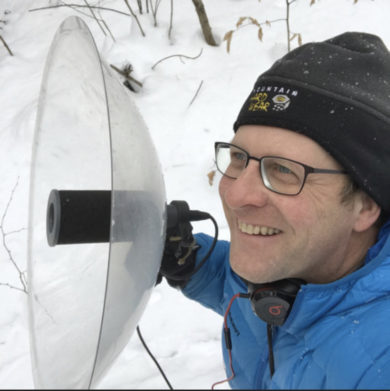VAL Awarded SciSTARTer Boost Prize
For over a decade, the Vermont Center for Ecostudies (VCE) has led in discovering and monitoring biodiversity. With the help of a legion of community scientists, VCE’s Vermont Atlas of Life (VAL) has spearheaded groundbreaking wildlife atlas projects from butterflies to bumblebees and online crowdsourced projects like e-Butterfly, Vermont eBird, and iNaturalist Vermont.
Last week, Kent McFarland, director of VAL, was recognized on behalf of the team’s work with a 2022 SciSTARter Boost Award. Ten individuals received this inaugural award for their outstanding work with community science.
“The Vermont Atlas of Life wouldn’t be possible without thousands of deeply interested volunteers helping us discover and monitor our amazing natural heritage. It has been a real boost for me to work with all these folks and the amazing VAL team over the last decade,” said McFarland.
SciStarter grew from a University of Pennsylvania graduate school project founded by Darlene Cavalier. Through this project, she hoped to learn how people without science degrees (like Cavalier) could meaningfully engage in science. SciStarter is the largest online database of community science projects and helps millions of people find, join, and contribute to more than 3,000 research projects in need of volunteer help.
In 2023, VAL will celebrate its 10th anniversary. However, its origins began decades ago when hundreds of community scientists joined VCE biologists to complete groundbreaking wildlife atlases for butterflies, breeding birds, and bumblebees.
“We realized that, despite our atlasing efforts, there were thousands of species for which we had no information. We needed to bridge critical gaps in the loose network of naturalists, students, scientists, organizations, and government agencies collecting biodiversity knowledge here in Vermont and across the planet. That spawned the Vermont Atlas of Life project,” said McFarland.
The Vermont Atlas of Life collects biodiversity data from its crowdsourced projects, wildlife atlases, population monitoring projects, and even rescues priceless historical data. It then integrates these diverse datasets into a globally recognized framework called Darwin Core so that scientists, analysts, and policymakers can use them in research, conservation, and policy. As one of the 2,300 biodiversity data publishers in the world, VAL shares these with the Global Biodiversity Information Infrastructure (GBIF), an international network and research center funded by the world’s governments and aimed at providing anyone, anywhere, open access to data about all types of life on Earth.
“Today, VAL has nearly 8 million mapped records of over 14,000 species across Vermont, largely thanks to the contributions of tens of thousands of naturalists,” says McFarland.
These data help shed new light on Vermont’s biodiversity. Just this year, in partnership with the Vermont Fish & Wildlife Department, VAL released Vermont’s first-ever comprehensive report on the state of wild bee populations. The report found that at least 55 native bee species are in immediate need of conservation.
Looking forward, VAL is preparing to release a 10-year report in early 2023 that uses its millions of biodiversity records to help understand the current state of Vermont’s biodiversity, how it might change in the future, and what we can do to conserve our natural heritage.
“We are so thankful to have thousands of people helping us to discover and monitor Vermont’s biodiversity; it can’t be done without them,” said McFarland. “In the coming years, we hope even more people will join us to discover, observe, and conserve this incredible biodiversity that calls Vermont home.”







